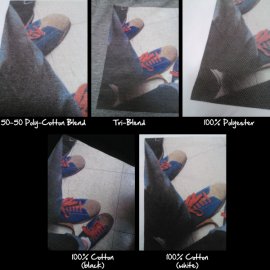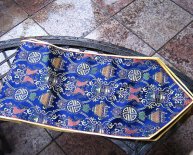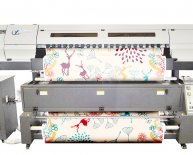
Digital printing on cotton fabric
 Cole: It's not no polyester, it's pretty much no polyester. The fibers of polyester are extremely fine and made of plastic. Plastic is not absorbent, so printing with water-based inks doesn't work well.
Cole: It's not no polyester, it's pretty much no polyester. The fibers of polyester are extremely fine and made of plastic. Plastic is not absorbent, so printing with water-based inks doesn't work well.
The 100% no-polyester scenario is white inks. White uses metal, titanium dioxide, and therefore it is really heavy on a molecular level. This can be seen on any garment: if you print white without an underbase, the visual effect is similar to if you just spilled some milk on the shirt - your brain would see the spot and think "stain!" or "wet!" but not "white!" The same thing is true for the ink as the milk (as a matter of fact, milk has been used as paintfor millennia).
Well, what about polyblends?
B: Polyblends work only partially for the reason you might assume - because of the fibers that make it a blend - there's something for the ink to attach to besides polyester. Think of when you've spilled water on something cotton - you got wet and stayed wet. Think of spilling water on a synthetic material - it either beads up or it passes right through. The same thing happens with the ink. When more absorbent fibers are present, the ink has more to adhere to.
 Are there any other materials to avoid completely?
Are there any other materials to avoid completely?
B: Plastics of any kind, unless you don't care about your print holding up.
Are there any textiles other than 100% cotton that can be used for digital printing?
B: Other non-cotton materials often stand up fairly well to the process - fabrics such as wools and silk do well when printed on, but have extremely fine fibers. A white underbase is not recommended, and frankly, I wouldn't do it without a waiver from the customer. I have personally printed on linen (flax) and hemp, two other non-animal materials, with great success. To say that only cotton can be printed on is a misnomer.
What's the trickiest material you've ever printed on, and how did it turn out?
B: As far as textiles go? Linen is a real pain. I recently posted about printing on linen. As you can read and see, it is very tedious business. The final product is stunning, however. That's really the fun of printing in general - the challenge: can we really print on that?
Fully agreed. Any other advice?
B: As far as custom apparel goes, just remember: your job can be fast, high quality or inexpensive, but realistically they're mutually exclusive. Also, eat more pizza.
We put the big contenders to the test: 50/50, tri-blend, polyester, and cotton (black and white).
Here are the results after the same printing, curing, and washing (inside out in cold water, please!) treatment.

















